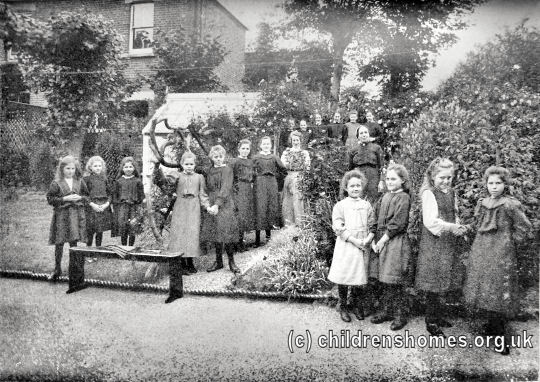The Ladies' Association for the Care of Friendless Girls
The Ladies' Association for the Care of Friendless Girls (LA) was founded in 1883 under the auspices of the Church of England, at the initiative of the women's campaigner Ellice Hopkins. The LA's formally declared object was 'to prevent the degradation of women and children', in other words to prevent girls and women from falling into prostitution because of their social, economic or family or other circumstances. The LA operated as a confederation of locally run Associations, which by 1885 numbered 106.
The LA had four main strands to its work:
- The Moral Education Branch sought to provide good moral teaching and to promote purity and chastity. This was aimed at both men and women, but still viewed women as being largely responsible for putting this into practice, with an emphasis on women's roles as wives and mothers. The Moral Education Branch founded several other organisations through which to channel its message:
- The Mothers' Union — for mothers of all backgrounds, providing guidance on the moral education of children.
- The Women's League — for middle-class women, encouraging them to offer a moral model to other women and girls.
- Snowdrop Bands — clubs for young (11+) working class young women. The club magazine, The Snowdrop, featured moralistic stories.
- The Petitioning Branch lobbied Parliament to take a stronger stand against prostitution, for example, by protecting girls from those who wished to seduce them. The Association's support was instrumental in the passing of the Criminal Law Amendment Act of 1885 which raised the age of female sexual consent from 13 to 16. The same Act also gave police greater powers for the prosecution of streetwalkers and brothel-keepers.
- The Preventive Branch established training homes, registry offices and clothing clubs for domestic servants. The homes provided training in the skills of domestic service for girls considered at moral risk, with the registry helping trained girls to obtain a position or to move to a new one. Clothing clubs helped provide the uniform which girls were usually expected to possess when entering a new situation.
- The Workhouse Magdalen Branch helped young, single, first-time mothers who, without family or other support, were often forced to enter workhouses. Such girls were viewed as particularly susceptible to resorting to prostitution in order to support themselves and their infant, the alternative being to give up the baby. Associations tried to help girls find positions with a sympathetic employer and arrange fostering for the child. Some LA-run homes, such as those in Oxford, Exeter and Liverpool, eventually also provided accommodation for babies while their mothers worked elsewhere.

Hastings Ladies' Association Home, c.1915. © Peter Higginbotham
Ladies' Associations had largely disappeared by the Second World War. In some cases, the running of their residential homes — often given names such as the 'House of Help' — had been taken over by the local Anglican Diocese or some other body.
A list of LA-run homes and their locations, where known, is given on a separate page. Some of the homes changed location over the years and so have more than one address.
Records
Note: many repositories impose a closure period of up to 100 years for records identifying individuals. Before travelling a long distance, always check that the records you want to consult will be available.
- Any surviving records for individual Ladies' Associations will generally be found at the local record office or archives covering the location.
Bibliography
- Bartley, Paula Prostitution: Presevntion and Reform in England, 1860-1914 (2000, Routledge)
Links
- None identified at present.
Except where indicated, this page () © Peter Higginbotham. Contents may not be reproduced without permission.


